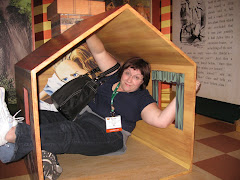How do you represent a culture honestly, without inadvertently reinforcing stereotypes? In the cultural area, there is a space dedicated to a depiction of an African child's room. I'm adamant that we make sure this space is defined as a country. However, choices have been made that are directing my selection of a country to focus on.
Do I: Theme the room based on the existing outside architecture, and inadvertently reinforce the idea that everyone in Africa lives in abject poverty? Or do I ignore the external architecture and choose a more middle class style room, and fail to be true to the diversity of the continent?
I'm honestly unsure. When I was in Indy, in the Egypt gallery, we had an urban and a rural bedroom. I often overheard "look at the poverty" from our upper middle class visitors. How do we get across the dual ideas that yes, these countries do not have as much as we do, but that doesn't mean that their lifestyle is poor. In fact, what I see is that I could really be happy with less. Seeing these spaces doesn't make me sad for them, it makes me sad for the US and our rampant consumerism.
But back to Africa.
What do you all think? Does a thatched roof drive the choice toward a rural/tribal home? Because that means the bed will be nothing more than sheets on the floor. Or should I settle on Kenya and "average" the interior decor? I'm leaning to the latter, but am concerned. I'm going to have to dig my heels in and get some cultural voices in on the conversation. Because as much as I need to move quickly, I also need to make sure this is done right.
Anyone have advice?

3 comments:
Okay, so you know I am not a museum expert, but since you specifically referenced an exhibit I have visited a couple of times, I want to share something that occurred to me as I read about your challenge. I love learning about other cultures, and when I went through the homes in the Egypt gallery, I didn't necessarily think that they were poor, but as you said, that they have less. I think what helped clarify that for me were the "families" that "lived" in the homes - the pictures and text that explained what I was seeing made it personal. Those people seemed happy and therefore not poor. Does that make sense? Whatever you decide to do, make it personal.
That helps SO MUCH! Its going to be a challenge, but I think we can do a narrative that lets us personalize things. You rock!
Fully realizing that this is not one in the same, in developing programs that deal with slavery and the origins of African-American culture I finally achieved an equilibrium through discussion with friends from a variety of African countries, and African-American friends of varying ages. Those from Africa ran the gamut from an MD and a PhD to those without formal education - east coast to west coast of the Continent.
In doing so I found that even amongst this random sampling there were preconceived notions about each others cultures and standards of living. Still, it gave me a perspective I otherwise would not have as a white American woman.
Maybe it takes stepping away from the parameters of a museum to realize an answer. And, that perhaps there is more than one view that can be presented within the exhibit. Dare I suggest portraying a story rather representational of the modern world - of a young individual whose life brings him/her from a village culture to a metropolitan environment - or, vice versa?
Just a thought. I look forward to visiting in the near future.
FrannMarie at Presenting Our Past, LLC
Post a Comment